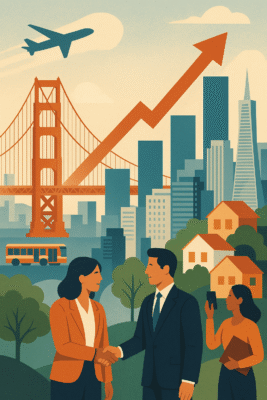
The Bay Area—long hailed as an economic powerhouse—finds itself in a period of both cautious optimism and ongoing transition. After years of pandemic disruptions, tech slowdowns, and shifting work patterns, the region’s economic heartbeat is once again gaining rhythm, though not without notable challenges.
Job Growth and Unemployment: Signs of Stability
Unemployment rates in the broader Bay Area have remained relatively steady, hovering close to 4%, which is near pre-pandemic levels. This stability reflects a slow but sustained recovery across sectors. Hospitality, construction, and healthcare have led the hiring momentum, benefiting from rebounding tourism and infrastructure investment.
However, the job market’s strength is uneven. While some industries have regained their footing, the tech sector—once the undisputed engine of Bay Area job creation—has yet to return to its peak hiring pace. Layoffs over the past two years have given way to more cautious staffing strategies, with companies prioritizing profitability over rapid expansion.
Tech Sector Trends: From Hypergrowth to Maturity
The Bay Area’s tech scene remains influential, but its profile is changing. The era of aggressive headcount growth and lavish office expansion has cooled, replaced by a focus on AI innovation, efficiency, and hybrid work models.
San Francisco and Silicon Valley continue to attract venture capital, though at a more selective pace, with investors channeling funds toward artificial intelligence, clean energy tech, and biotech. Startups are adapting to a higher interest rate environment, pushing them to prove business viability sooner.
Housing Market: Prices Stay High Amid Shifting Demand
The housing market has seen modest softening in sales volumes, but prices remain stubbornly high. A shortage of available homes, combined with slow construction, keeps affordability a pressing issue.
Urban San Francisco faces higher office vacancy rates due to remote work trends, but residential demand in certain neighborhoods remains steady, buoyed by professionals seeking proximity to cultural amenities. In the suburbs, particularly in Marin and the Peninsula, demand for spacious homes with outdoor access remains strong, driven by hybrid work flexibility.
Budget Outlook: Tight Margins and Strategic Spending
Local governments are contending with budget gaps, fueled by declining commercial property tax revenues and shifting retail patterns. San Francisco, for example, is reevaluating spending priorities, investing in economic revitalization projects while trimming less essential programs.
Public transit funding remains a major concern, as reduced commuter traffic threatens revenue streams for BART and Muni, prompting calls for regional funding solutions.
Tourism: Gradual but Steady Comeback
Tourism—once one of San Francisco’s biggest revenue drivers—is rebounding. Hotel occupancy rates and convention bookings have improved significantly since 2022, though they haven’t yet reached pre-pandemic highs. Marketing campaigns are targeting both domestic and international travelers, with a particular push to restore confidence in downtown safety and cleanliness.
Finance and Startups: A More Disciplined Landscape
The finance sector remains steady, bolstered by wealth management and fintech innovation. However, risk appetite is more measured than during the tech boom years. Startups now face a funding environment where resilience, cost discipline, and clear revenue strategies are paramount.
Urban Development: Adapting to a Hybrid Future
Urban planners are reimagining downtown areas for a post-pandemic economy, with proposals to convert underused office buildings into housing, create mixed-use districts, and expand green space. These efforts aim to balance the loss of traditional commuter traffic with the growth of neighborhood-focused economies.
The Road Ahead
The Bay Area’s economic future will be shaped by its ability to diversify beyond traditional tech, address its housing crisis, and modernize its urban core. While challenges in affordability, public transit, and fiscal stability remain, the region’s deep talent pool, innovation culture, and global connections suggest it will continue to adapt and lead.
In 2025, the Bay Area is no longer chasing the breakneck growth of the past decade—it’s building a more resilient, balanced foundation for the decades ahead.